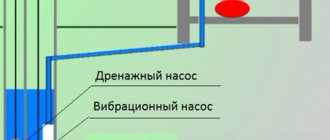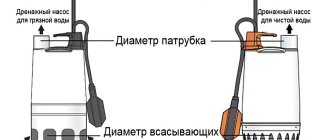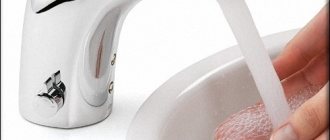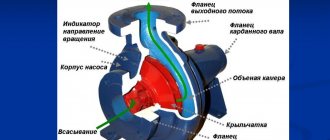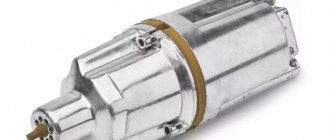The appearance of water in the basement can be due to a number of reasons. One of the most common problems is groundwater.
What causes water to seep into the basement from the ground? Firstly, there is improper drainage around the basement. Secondly, the drainage may become clogged. Thirdly, there is improper or damaged construction of the basement wall waterproofing. Fourthly, there may be too much groundwater supply due to above-normal precipitation or intense snow melting due to seasonal abnormal warming.
The problem of groundwater in the basement can be solved in various ways. Most of these methods can be done independently. But even after eliminating the problem of groundwater appearing in the basement, it must be removed from there. This can be done by pumping using various means and devices.
How to deal with basement flooding
Flooding of basements with groundwater and melt water, especially in spring, is quite common. You can protect against the ingress of melt water by properly installing external waterproofing of the foundation and blind area around the house, which will not help against ground water, when the ground absorbs moisture like a sponge that is soaked in it.
When the basement is located below the groundwater level, liquid enters the basement through all available places on the walls and floor planes.
Waterproofing only affects the walls, so it will not save you from groundwater.
From complete flooding you need to:
- Lower the groundwater level.
- Install a waterproof barrier.
How to get rid of water in the cellar
When a flooding problem occurs, you need to find out the reasons in order to plan further actions.
There are a number of reasons why a cellar floods
Causes of flooding:
- high lying groundwater;
- accumulation of precipitation after prolonged rains in the absence of a drainage system;
- leakage of melt water through cracks in walls and foundations. Often found in lowlands;
- water breakthrough from a pipe located in the basement;
- poor ventilation, which contributes to the appearance of condensation and dampness.
Read more: do-it-yourself ventilation in the cellar.
How to arrange drainage
This method makes it possible to combat high groundwater levels. But this method cannot be used in any case.
The design of the drainage system is the removal of water:
- Through the ditches. Digging deep ditches on a site is quite dangerous and does not decorate its appearance, which makes this process not applicable for domestic purposes. With their help, you can, for example, dry out a swamp to organize a place for a vegetable garden.
- Special drainage pipes. Typically this is a pipe with a diameter of 100 mm, on which small holes are drilled over the entire surface. The pipe is buried to a drainage depth that is below the floor level of the room, sloping away from the house, with free water outlet.
Advice: It is possible to use such a system only in areas where there is its own slope, which will ensure natural flow of liquid and its free exit at the end of the pipe, as shown in the photo.
Drainage system design
A drainage system installed around the home alone or in combination with other basement drainage methods produces excellent results and eliminates the root cause of flooding.
A private house
When building a house on a site, it is important to determine the level of groundwater. You can determine it yourself, focusing on the degree of water filling in the well, or order geological exploration services.
The latter method is more reliable, in which recommendations are given on the location of a private house, foundation and drainage system.
Attention! It is better to determine the water level in the spring when the snow melts or in the fall, during the rainy season.
The likelihood of a high occurrence can be determined by the plants that grow on the surface. Alder, willow, horsetail and reeds grow well.
At a high level (at a depth above 2 meters from the surface of the earth), a negative effect occurs on a house standing in water:
- The liquid that sits in the basement provokes dampness and mold development.
- Moisture can cause the foundation of a house to collapse.
- Excess water negatively affects the greenery and trees growing on the site, on the paths, washing them away, and washing away the walls of the house.
How to set up an automatic water pumping system
What if the area is flat and there is no slope? In this case, there will simply be nowhere to remove the drainage pipe. A simple way to drain a basement is to install an automatic liquid pumping system.
To do this you need to do:
- Organize a pit inside the basement. A hole is dug measuring 500 x 500 mm and no less than half a meter deep. The walls are strengthened with brickwork, which will prevent them from crumbling over time. The bottom is filled with gravel 100 mm thick.
- A drainage pump for pumping water from the basement, with an automatic control system, after reaching a certain water level, is installed in a pit.
- The hose connected to it is directed away from the house.
- An increase in the groundwater level is accompanied by its appearance in the pit.
- After reaching a certain point, which depends on the pump settings, for example, when reaching the top of the pit, liquid pumping will begin, and excess moisture will be removed by the pump. As it accumulates further, the pump will turn on and pump out the water again. This will continue until the primer level goes down. If its increase is associated with the snow melting process, then the pumping system will operate from March to May.
This is a simple and reliable system. Its price depends mainly on the cost of the pump. The disadvantage of the system is that it does not eliminate the problem as a whole, but provides only a temporary solution that depends on the service life of the pump.
What is a basement pump?
This is not specifically specialized equipment that serves exactly this purpose. A conventional drainage, sewage or surface pump is optimal for pumping out water. They can be used not only to drain the basement, but also for many other purposes:
- for pumping water out of trenches and pits during construction;
- for draining swimming pools, pumping water from various reservoirs;
- for watering garden and vegetable crops from lakes, barrels, etc.;
- when replacing water in decorative ponds and reservoirs.
Technical features of using different types of pumps for draining basements.
Surface pumps for the basement.
In this case, the pump itself is on the surface, and the supply hose is lowered into the basement, into its deepest place. The problem in this case may arise as follows - blockage of the suction hole with various debris in the water. We recommend making sure that there will be no problems with this or using an additional mesh. In this case, the entire process should be monitored, since not all surface pumps have dry-running protection, and if water stops being sucked in, the equipment may simply fail.
Sewage pumps for the basement.
This option is more preferable, since most models are equipped with a float, and when the water level drops to critical, it automatically turns off. Almost all models have the following feature - the suction hole is reliably protected from large inclusions, this is important if debris, leaves, etc. get into the basement. Some models of fecal pumps are equipped with a chopper blade, which is an additional insurance against blockage. Such equipment is always a problem-free solution.
Drainage pumps for the basement.
As a rule, basements and cellars in Russia are filled with melt water in the spring, or groundwater comes too close. That is, the water level simply rises in this room, without much debris or pollution. In this case, the optimal and most cost-effective solution would be to use a drainage pump. Most of these models are designed for pumping dirty water, with inclusions of a certain diameter, so there should be no problems. Any correct drainage system, like its fecal counterpart, is equipped with a float for automatic shutdown and thermal protection. The choice of a specific model depends on technical tasks and personal preferences.
In most cases, we recommend using a drainage pump for this task, as it is the best option in terms of price and technical requirements.
Features of basement pumps, what determines the price
We recommend paying attention to the following parameters of this equipment (we are talking about fecal or drainage pumps).
- Pressure is measured in meters. This indicator indicates to what height the pump can supply liquid. That is, when purchasing, you should take into account the depth of the basement and the drainage level. Naturally, the price of models with a high pressure indicator is higher.
- Productivity - in cubic meters per hour. The volume that the pump can pump out per hour. Different models have different performance, with larger ones costing more.
- Power - in kW. This is actually the device's power consumption. The higher the pressure and productivity, the more electricity is consumed.
- Case material. There are several options here - plastic housing, cast iron, stainless steel and intermediate models, including, for example, parts made of both plastic and stainless steel. The budget option itself is a plastic case. Stainless steel also has a longer service life, and in the event of accidental impacts, the case will not crack or break.
- Availability of pump protection systems - from overheating, automatic shutdown when the water level drops. All this will allow the equipment to operate for many years without unnecessary problems.
The higher the pressure, productivity and power, the higher the cost of the equipment; additional options in the form of a stainless steel body and protection options also increase the price of the product.
Waterproof barrier in basement
Let's consider two cases:
- The enclosing structures of the basement are made of monolithic concrete with pouring in one approach: in this case, the walls and floor need only be treated with coating waterproofing with a penetrating effect. It is made on the basis of Portland cement, to which finely ground quartz sand and active chemical elements are added. Upon contact with water (the mixture is applied to a wetted surface), these components form crystals that fill pores and microcracks in concrete.
- There are seams in the walls and floor or at their junctions: in this case, you will have to use a waterproof barrier with a multi-layer structure.
It is done like this:
- The seams between individual blocks and cracks are puttied with a mixture of sand and concrete or with a special waterproofing compound, for example, Penecrit. Along the seams between the walls and the floor, you can lay a plinth made of a cement-concrete mixture with a height of 40 - 50 mm.
- After the mixture for joints has dried, a coating waterproofing with a penetrating effect, for example, “Penetron,” is applied to the cleaned surfaces of the walls and floors (pores and microcracks must be opened). Layer thickness – from 1 to 2 mm. Can be applied either with a roller or a brush. The composition is applied in two layers, but the first must first dry completely.
- Next, all surfaces should be treated with a reservation solution. Armoring mixtures are called mixtures that, like penetrating waterproofing, are made on the basis of cement and are of the coating type, but have a slightly different composition. This solution is also applied in two layers, the second after the first has dried.
- If there are leaks anywhere, they need to be treated with a thicker armor solution.
For the best effect, the floor can be treated with a type of mastic - the so-called liquid rubber, for example, "Elastopaz" or "Elastomix".
Causes of flooding and pump selection
There can be several reasons for flooding of a basement or ground floor:
- seasonal flooding of underground buildings during spring floods;
- close occurrence of groundwater;
- burst of water supply or sewerage.
It is the reasons for flooding of basements and basements that are an indicator of which pump to pump water from the basement to choose.
In the case of seasonal flooding, water can be pumped out from the basement once a year after the flood has passed and the water has settled below the level of underground buildings. That is, there is no need for the pumping device to be permanently located in an underground room.
In the case of close groundwater, the drainage system must operate continuously. Consequently, the pump is installed during construction in a special collection tank and is removed from there only for maintenance. In such situations, the drainage pump should work automatically: turn on when the water reaches a certain level and turn off after pumping it out without human intervention.
If the flooding of the basement occurred due to a break in the water supply or sewer system, the situation changes somewhat. In this case, of course, the pump is used once, but other nuances arise here. In case of a break in a cold water supply, any drainage pump will do.
Motorized pump
If hot water pipes rupture, the pump should be selected based on the temperature characteristics of the pumped medium.
If the cellar or basement is flooded with the contents of sewer pipes, a fecal pump will be required. The peculiarity of the fecal unit is that it is capable of pumping liquids interspersed with solid particles of large diameters or even grinding them.
Things to consider when getting started
- Do you have little time to properly prepare for the event or do you need to act immediately?
- Assess readiness for the procedure. This is the presence of experience in carrying out such work, a supply of necessary tools and devices.
- Understand at what speed water enters the basement. This is necessary in order to determine the possibilities for its removal. For example, if the liquid continues to drown the room, and you try to cope with such devices as buckets and a shovel, then this will lead to nothing. You may need to use a pump that has good power.
Of course, you can use devices such as a bucket and shovel, but this is only if the water is no longer flowing and a small amount has accumulated.
Safety rules when working with pumps and pumps
Safety requirements when using submersible drainage pumps:
- During operation, do not touch the liquid, cable, or objects that come into contact with water - there is a danger of electric shock;
- After each use, run clean water through the pump or rinse it;
- do not forget to remove the plug from the socket after completing all tasks.
Safety requirements when using motor pumps:
- do not work in a closed, poorly ventilated area;
- Always stop the engine before refueling and allow it to cool;
- do not refuel the motor pump near an open flame, do not smoke during the process;
- Do not allow fuel to come into contact with the engine or muffler during refueling;
- install the motor pump at a distance of at least a meter from the walls, do not allow children and pets to be nearby - the device gets quite hot;
- Do not touch a running or just switched off engine with your bare hands.
Types of household pumps
The entire variety of pumping equipment can be divided into several types:
- drainage devices;
- fecal pumps.
How do they differ from each other? In terms of operating principles, there are no significant differences between them. And all because the main task for which they are purchased is pumping out liquid.
If we talk about drainage pumps , then depending on their model, these installations can pump small fragments of solid waste along with water. To prevent damage to the mechanical parts of this pumping equipment, a filter made of a mesh with small cells is installed on the lower section of the pipe. Filter products are made of material that is not subject to corrosion. If there is a filter, particles will not get inside the equipment.
A fecal pump for pumping water from a basement differs from a drainage pump in that it does not have such a filter. Its main purpose is related to pumping wastewater and soft inputs like paper. To ensure high efficiency of its operation, depending on the model, it can be equipped with a cutting mechanism, which crushes large particles during operation of the equipment.
According to such a criterion as the method of operation in a liquid medium , both types of pumping equipment are divided into:
- submersible;
- external.
When a submersible pump is used to pump water, it is completely submerged in wastewater. Pumps of the second type are immersed in the aquatic environment with their lower part, and the main one is located outside. Pumping out wastewater and groundwater is carried out by a small part of it, which is lowered into the aquatic environment.
Selection rules
The choice of any electrical equipment must be taken seriously. Basement pumps are no exception. Before you go to the store for such a purchase, you need to understand where, for what and how often the pump will be used.
The first characteristic you should pay attention to is performance. It is calculated based on the amount of liquid that needs to be pumped in a certain unit of time.
The second is the depth of the pumped out reservoir.
It is better that the equipment has a 30% power reserve relative to your calculations. This will guarantee its protection from overloads and unexpected breakdowns.
Fecal pump with grinder
When choosing a submersible model, you need to pay special attention to the material and tightness of the housing. Saving on quality can lead to corrosion and failure of the pump in the first months of its operation.
When choosing a pump for permanent drainage, it is better to give preference to automatic devices. This will completely free you from responsibility for its operation and the user’s forgetfulness will no longer cause the unit to break down.
And finally: you shouldn’t skimp on electrical equipment so you don’t have to pay twice. It is better to buy such units in specialized stores and choose trusted brands. In this case, you receive a guarantee and the possibility of service.
Where to start when choosing
Start your choice with the following - measure the height of the rise of water from the basement to the surface. This is an indicator of pressure. Naturally, it is better to choose a model with a small margin for this parameter.
Next, calculate the approximate volume - how many cubic meters of liquid you will need to pump out, and by comparing it with the pump’s performance, it will become clear over what period of time this is possible.
Need to drain your basement quickly?
- take a model with high performance, but it will be more expensive. Do you have time? A low-performance pump with the same pressure rating will be sufficient.
Five main mistakes when choosing a device for pumping water
- Purchase of a surface pump for pumping water from great depths. If the depth of the well is more than nine meters, only a submersible device will cope with the task.
- Attempt to work with chemical liquids. Most household appliances are designed only for pumping water. To operate in aggressive environments, pumps made of special durable materials are used.
- Choosing a weaker pump to save on electricity. A 1000 W pump will do the job in an hour, a 400 W pump in 2.5 hours. Electricity consumption will be the same. It is worth considering the depreciation of the engine: the less time the engine runs, the longer it will last.
- Choosing a more powerful motor pump than required for work. To pump water from a shallow basement and irrigate a small garden, a device with a capacity of up to 20,000 l/h will be sufficient. If you buy a device with a higher power, then a) you will overpay for the machine itself, b) during operation you will pay more for fuel and maintenance.
- Misreading the characteristics. Manufacturers indicate maximum values calculated based on operation at so-called “zero points,” ideal conditions. Example: a motor pump with a power of 400 W, a capacity of 7000 l/s and a lifting height of 6 m. Task: to lift water from a well 3 meters deep and drain it into a tank located at a distance of 30 meters. Bottom line: the pump will not cope with this task due to the losses that will occur when lifting and pumping water.
Schematic overview of the well pump design
- The housing combines all existing elements of the electric pump. The material for its manufacture is metal, since the polymer is not able to withstand the load exerted on a mechanical object.
- The rotor provides pumping of excess moisture. By making rotational movements, it pumps out water, which falls into the hose under pressure.
- The rotor rotates via a rigid shaft. In addition, many different elements are responsible for the workflow. A high-quality device is equipped with a more complex technical device, but at the same time it has a longer service life due to reduced wear of spare parts.
Drainage pump for cesspool
Such pumps are quite often used in country houses. An example of such equipment is the well-known “Malysh” pump. It can be considered as a station that provides the rise of water from a variety of sources. In domestic conditions, such pumps are most often used for watering plants in the garden. Some use them to organize individual water supply in their private household.
It is worth saying that drainage pumps used for water supply or autonomous sewerage can work not only on the surface of the site, but also at the bottom of the cesspool.
Pump "Baby"
This device belongs to the group of submersible-type installations, which, when used, are located in a tank with waste water. After installation, a pipeline is connected to it, through which liquid is pumped out to the surface. When installing the device, the following requirements must be met: the lower part of the pump should not be located at the bottom, since water is drawn from below. In a tank with wastewater, there is a layer of sludge at the bottom, which can clog the intake part of the equipment. Special cooling of the electric motor parts of the submersible pump is not required, since the temperature reduction occurs due to the low temperature of the waste water.
Both types of septic tank drainage pumps can be equipped with switches. regulates the level of water pumped out by the pump When a certain level of wastewater is reached, the mechanism automatically disconnects the device from the electrical network. When the maximum level of wastewater is increased, the device turns on and begins to pump sewage. The “Malysh” pump has a number of design features. One of them is reliable waterproofing of the housing, which is due to the use of equipment in an aquatic environment.
If the seal of the housing is broken, water will penetrate into the electric motor, which will lead to its failure. To ensure long-term operation of the equipment, it is necessary to periodically remove it from the water and carefully inspect the body.
Fecal pumps for cesspool
To pump wastewater, household pumps designed for sewage, fecal type, can be used. Regarding the location, they can be installed outside or inside the container itself.
Unit power
You need to choose the pump performance taking into account the area and depth of the basement. For example, for a room of up to 20 m2, you can use a device with a power of 100-120 l/min. For smaller basements, 40-50 l/min will be sufficient.
If the site has a slope from the basement, then water can be removed in the following way:
- prepare a hard plastic pipe, which is similar to the intake pipe used for the surface pump;
- make a hole from the basement towards the slope;
— the pipe should be immersed with one edge in water;
- the other should be located where there is the greatest slope on the site;
- in order for the water to start flowing by gravity, you can use a vacuum cleaner.
AllaAuthor of the article
Did you like the article?
Share with your friends:
What types of basement pumps are there?
All water pumps are divided into two subtypes:
- Mechanical.
- Electrical.
Mechanical or hand pumps are driven by human physical force. Based on their operating principle, such pumps are called piston pumps. It is the movement of the piston that sucks water into the pump bowl and then pushes it out.
These devices are indispensable in cases where there is no electricity in the area. However, it is worth noting that pumping water with such devices takes a lot of effort and time, so it is impossible to pump out large volumes of liquid and even in a short time.
Electrical devices are much more expensive than mechanical ones and require additional energy costs. However, these units are able to create maximum comfort and fulfill any user requirements without expending physical effort. In addition, almost all electrical units can be combined with various types of automation and switch them to fully automatic mode.
Grundfos sololift pump
The main advantage of these pumps, which are distinguished by their high price, is that they can be installed in various parts of the house. This is especially important for those owners whose plumbing fixtures are located below the drainage point. Pumps can be installed on any plumbing product. To place it in the bathroom or kitchen near the sink, you can use a regular pump. But for the toilet room, you should choose a model equipped with a cutting mechanism that will crush large particles, including paper. The presence of such a grinder allows the use of smaller diameter pipes for the sewerage system, which will reduce the cost of installing a wastewater disposal system.
Advantages of Grundfos sololift pumps
- Installation of such equipment can be carried out in any room in the house, regardless of in which part of the building the outlet pipe of the sewerage system is located;
- These devices are distinguished by their versatility of use. Their installation can be carried out on a separate device, or they can pump out wastewater coming from all plumbing fixtures located in the bathroom;
- this equipment can be equipped with a waste shredder, which allows the use of small diameter pipes for sewage;
- This equipment is characterized by high reliability and long service life;
- pumps from this manufacturer are distinguished by their aesthetic appearance and harmonize well with any interior;
- during operation it creates a small noise level, therefore, using it in the house, the owner will not encounter discomfort;
- The design of these devices includes an aerodynamic relay, which provides the ability to pump out wastewater automatically. When the set level is reached, the device turns off;
- the installation is equipped with an automatic system that turns off the pump if the electric motor overheats;
- Installation of such pumps is simple and convenient.
Harsh chemicals should not be poured down the drain . Otherwise, the performance and durability of the equipment may be affected.


